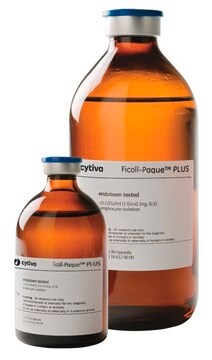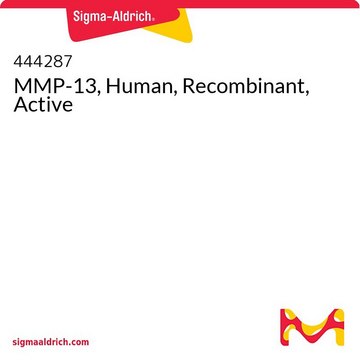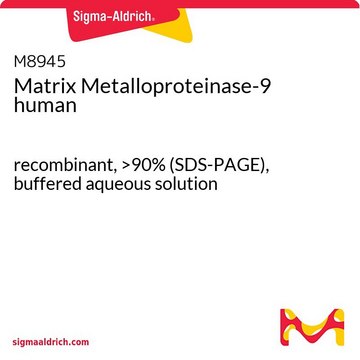CC1047
MMP-13, human, proform, his-tagged, E. coli recombinant
Synonym(e):
Procollagenase 3
Anmeldenzur Ansicht organisationsspezifischer und vertraglich vereinbarter Preise
Alle Fotos(1)
About This Item
UNSPSC-Code:
12352204
eCl@ss:
32160405
NACRES:
NA.77
Empfohlene Produkte
Biologische Quelle
human
Qualitätsniveau
Assay
>95% (total protein)
Form
liquid
Spezifische Aktivität
250-300 mU/mg
Hersteller/Markenname
Chemicon®
Konzentration
0.2 μg/μL
NCBI-Hinterlegungsnummer
UniProt-Hinterlegungsnummer
Versandbedingung
dry ice
Angaben zum Gen
human ... MMP13(4322)
Allgemeine Beschreibung
CC1047 is a recombinant 452 amino acid polypeptide corresponding to human Pro-MMP-13, with an additional C-terminal His-tag with the sequence GVTHHHHHH expressed in E. coli and purified from periplasm. The calculated Mr of the recombinant protein is 51.681 kDa. Upon activation with APMA activated MMP-13 is formed.
Matrix metalloproteinases (MMPs) are Zn2+- and Ca2+-dependent endopeptidases which function in the turnover of extracellular matrix components [Matrisian, 1992]. Main subfamilies of MMP are collagenases, gelatinases, stromelysins and membrane-type matrix metalloproteinases [Nagase, 1997]. Three homologous collagenases have been identified in human tissues: Interstitial collagenase, neutrophil collagenase and collagenase-3. These three enzymes cleave fibrillar collagens at a single site, generating fragments of approximately ¾ and ¼ the size of the original molecules.
ProMMP-13 [Procollagenase-3] consists of 452 amino acids with a calculated Mr of 52.520 [Freije et al., 1994]. Due to N-linked glycosylation, the actual Mr is about 60000 Da [Knauper et al., 1996]. Within the protein the following domains and sequence regions can be distinguished [Freije et al., 1994; Knauper et al., 1996]: An N-terminal propeptide, which confers latency to the proenzyme, a Ca2+ and Zn2+-ion binding catalytic domain, a hinge region, and a C-terminal hemopexin-like domain. Latent procollagenase-3 can be activated by proteases such as stromelysin [ Knauper et al., 1996], gelatinase A, MT1-MMP and plasmin [ Knauper et al., 1996] or incubation with APMA Knauper et al., 1996]. The Mr of active collagenase-3 which begins with the N-terminal sequence YNVFPRTL is 48,000 Da.
Collagenase-3 hydrolyzes type II collagen 5- to 6- times faster than type I and type III collagens. The enzyme also exhibits high activity towards gelatin and it degrades SERPINS as a1-antichymotrypsin and plasminogen activator inhibitor-2 [Knauper et al., 1996]. Collagenase-3 is inhibited in a 1:1 stoichiometric fashion by TIMP-1, TIMP-2 and TIMP-3.
Collagenase-3 is expressed during fetal bone development [Stahlebackdahl, 1997]. In adult human tissues collagenase-3 has been detected only in pathological conditions: in malignant tumors [Freije et al., 1994], in chronic ulcers [Valaamo et al., 1997], in arthritic cartilage [Mitchell et al., 1996] and synovium [Wernicke et al., 1996].
ProMMP-13 [Procollagenase-3] consists of 452 amino acids with a calculated Mr of 52.520 [Freije et al., 1994]. Due to N-linked glycosylation, the actual Mr is about 60000 Da [Knauper et al., 1996]. Within the protein the following domains and sequence regions can be distinguished [Freije et al., 1994; Knauper et al., 1996]: An N-terminal propeptide, which confers latency to the proenzyme, a Ca2+ and Zn2+-ion binding catalytic domain, a hinge region, and a C-terminal hemopexin-like domain. Latent procollagenase-3 can be activated by proteases such as stromelysin [ Knauper et al., 1996], gelatinase A, MT1-MMP and plasmin [ Knauper et al., 1996] or incubation with APMA Knauper et al., 1996]. The Mr of active collagenase-3 which begins with the N-terminal sequence YNVFPRTL is 48,000 Da.
Collagenase-3 hydrolyzes type II collagen 5- to 6- times faster than type I and type III collagens. The enzyme also exhibits high activity towards gelatin and it degrades SERPINS as a1-antichymotrypsin and plasminogen activator inhibitor-2 [Knauper et al., 1996]. Collagenase-3 is inhibited in a 1:1 stoichiometric fashion by TIMP-1, TIMP-2 and TIMP-3.
Collagenase-3 is expressed during fetal bone development [Stahlebackdahl, 1997]. In adult human tissues collagenase-3 has been detected only in pathological conditions: in malignant tumors [Freije et al., 1994], in chronic ulcers [Valaamo et al., 1997], in arthritic cartilage [Mitchell et al., 1996] and synovium [Wernicke et al., 1996].
Anwendung
ACTIVATION:
An aliquot of 19.5 μL procollagenase-3 is mixed with 0.5 μL APMA solution (40 mM p-aminophenyl mercuric acetate in DMSO) and the mixture is incubated for 30 minutes at 37°C. The mixture may be stored on ice until use for activity assays.
INHIBITORS:
MMP-13 is inhibited by TIMPs and by chelators of divalent cations such as EDTA or o-phenanthroline.
An aliquot of 19.5 μL procollagenase-3 is mixed with 0.5 μL APMA solution (40 mM p-aminophenyl mercuric acetate in DMSO) and the mixture is incubated for 30 minutes at 37°C. The mixture may be stored on ice until use for activity assays.
INHIBITORS:
MMP-13 is inhibited by TIMPs and by chelators of divalent cations such as EDTA or o-phenanthroline.
Einheitendefinition
Specific Activity: where 1 U is the activity that hydrolyzes 1 μmol peptide (7-methoxycoumarin-4-yl)acetyl-Pro-Leu-Gly-Leu-Dpa-Ala-Arg) within 1 minute (Knight, 1992).
Physikalische Form
Provided as a liquid in 50 mM Tris-HCl, pH 7.5, 150 mM NaCl, 5 mM CaCl2, 0.05% Brij-35.
Lagerung und Haltbarkeit
Maintain frozen at -70°C in undiluted aliquots. The enzyme may be stored at -20°C for several weeks without significant loss of activity. Repeated freezing and thawing should be avoided.
Hinweis zur Analyse
Pro-MMP-13 appears as a major band at about 60 kDa in SDS-PAGE
Rechtliche Hinweise
CHEMICON is a registered trademark of Merck KGaA, Darmstadt, Germany
Haftungsausschluss
Unless otherwise stated in our catalog or other company documentation accompanying the product(s), our products are intended for research use only and are not to be used for any other purpose, which includes but is not limited to, unauthorized commercial uses, in vitro diagnostic uses, ex vivo or in vivo therapeutic uses or any type of consumption or application to humans or animals.
Lagerklassenschlüssel
12 - Non Combustible Liquids
WGK
WGK 1
Flammpunkt (°F)
Not applicable
Flammpunkt (°C)
Not applicable
Analysenzertifikate (COA)
Suchen Sie nach Analysenzertifikate (COA), indem Sie die Lot-/Chargennummer des Produkts eingeben. Lot- und Chargennummern sind auf dem Produktetikett hinter den Wörtern ‘Lot’ oder ‘Batch’ (Lot oder Charge) zu finden.
Besitzen Sie dieses Produkt bereits?
In der Dokumentenbibliothek finden Sie die Dokumentation zu den Produkten, die Sie kürzlich erworben haben.
Activation mechanisms of matrix metalloproteinases.
Nagase, H
Biological Chemistry, 378, 151-160 (1997)
Distinct populations of stromal cells express collagenase-3 (MMP-13) and collagenase-1 (MMP-1) in chronic ulcers but not in normally healing wounds.
Vaalamo, M, et al.
The Journal of Investigative Dermatology, 109, 96-101 (1997)
P G Mitchell et al.
The Journal of clinical investigation, 97(3), 761-768 (1996-02-01)
Proteolysis of triple-helical collagen is an important step in the progression toward irreversible tissue damage in osteoarthritis. Earlier work on the expression of enzymes in cartilage suggested that collagenase-1 (MMP-1) contributes to the process. Degenerate reverse transcription polymerase chain reaction
Collagenase-3 (MMP-13) is expressed during human fetal ossification and re-expressed in postnatal bone remodeling and in rheumatoid arthritis.
St?hle-Backdahl, M, et al.
Laboratory Investigation; a Journal of Technical Methods and Pathology, 76, 717-728 (1997)
Cloning of collagenase 3 from the synovial membrane and its expression in rheumatoid arthritis and osteoarthritis.
Wernicke, D, et al.
The Journal of Rheumatology, 23, 590-595 (1996)
Unser Team von Wissenschaftlern verfügt über Erfahrung in allen Forschungsbereichen einschließlich Life Science, Materialwissenschaften, chemischer Synthese, Chromatographie, Analytik und vielen mehr..
Setzen Sie sich mit dem technischen Dienst in Verbindung.






